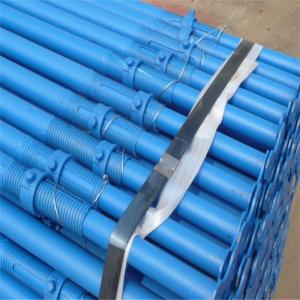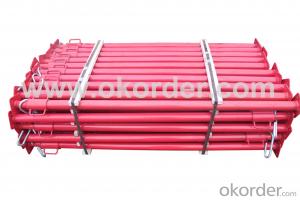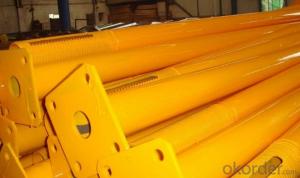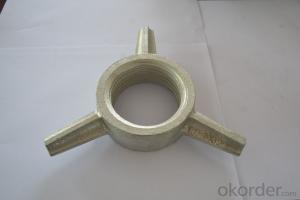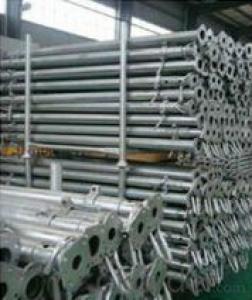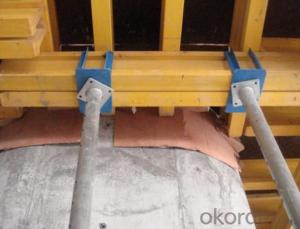Painted Scaffolding Post Prop Support
- Loading Port:
- Tianjin
- Payment Terms:
- TT OR LC
- Min Order Qty:
- -
- Supply Capability:
- 200000根 pc/month
OKorder Service Pledge
OKorder Financial Service
You Might Also Like
ProducGerman,Spanish,Middle East prop, steel pipe surpport.
Adjustable height:0.8-5.5m
Pipe/Tube tickness:1.5mm-4mm
Innner Diameter:40mm,48mm,etc.
Outer Diameter:48mm,56mm,60mm,etc.
Plate type:square,flower/clover,U-head
Nut type: single handle(common,7-style, big 7-style),Cup-style/Double handle
Pin type:line stright with metal cap,line straight without metal cap,chain,G-style
Plate size:120*12*4mm,120*120*5mm,140*140*5mm/5.5mm,etc.
Surface treatment: painted,galvanized,powder coating
Color:orange,red,blue,green,white,etc.
OEM ACCEPTABLE
Fast delivery wihtin 30days
Professional and reliable
We are specilized in various kinds of steel props, the goods are in high quality and reasonable price.In case you are interested in our products, please do not hesitate to contact me.
- Q:Can steel props be used for supporting temporary roofs?
- Yes, steel props can be used to support temporary roofs. Steel props, also known as acrow props or adjustable steel props, are commonly used in construction projects to provide temporary support to structures. They are designed to be adjustable in height, making them ideal for supporting temporary roofs of different sizes and shapes. The strong and durable nature of steel props ensures that they can bear the weight and provide stability to the roof structure. Additionally, steel props can be easily installed and removed, making them a convenient and efficient solution for temporary roof support.
- Q:How do steel props contribute to the overall cost-effectiveness of construction projects?
- Steel props, also referred to as adjustable steel props or steel shores, play a vital role in enhancing the cost-effectiveness of construction projects. They provide several advantages that aid in optimizing project costs and improving efficiency. To begin with, steel props possess exceptional durability and can be reused multiple times. They are typically constructed from top-quality steel, which imparts strength and resilience. This durability allows them to be utilized across various projects, minimizing the need for frequent repurchasing or rental expenses. Due to their ability to withstand heavy loads and harsh construction environments, steel props have a prolonged lifespan, resulting in long-term cost savings. Additionally, steel props are adjustable, enabling them to be employed for different applications and to accommodate varying heights and weights. This versatility eliminates the necessity of purchasing different types of supports for different requirements, thereby reducing costs associated with acquiring multiple products. The adjustability factor also facilitates easy adaptability during construction, minimizing downtime and increasing productivity. Steel props have relatively lightweight characteristics, making them easy to transport and handle on-site. This attribute translates into reduced labor costs, as the installation and removal of steel props can be carried out swiftly and efficiently. Furthermore, their lightweight nature simplifies logistics, allowing for the transportation of a greater number of props in a single trip, thus minimizing transportation expenses. The stability provided by steel props ensures a safer working environment. By offering reliable temporary support, they help prevent accidents or structural failures, which could result in costly delays, repairs, or litigation. Their strength and stability contribute to the overall efficiency and productivity of the construction process, reducing the likelihood of rework and conserving valuable time and resources. Moreover, steel props offer cost savings through their ease of maintenance. Unlike other temporary supports, such as timber props, steel props are not vulnerable to rot, decay, or damage from pests. This eliminates the need for frequent replacements or repairs, resulting in reduced maintenance costs throughout the project's lifespan. In conclusion, steel props enhance the cost-effectiveness of construction projects by offering durability, reusability, adjustability, ease of transportation, stability, and low maintenance requirements. These benefits translate into reduced project costs, increased efficiency, improved safety, and longevity. By investing in steel props, construction companies can optimize their budgets and achieve successful project outcomes.
- Q:How do steel props contribute to the prevention of concrete slab cracking?
- Steel props, also referred to as steel supports or scaffolding, are crucial in the prevention of concrete slab cracking. They contribute in the following ways: 1. Load distribution: Steel props evenly distribute the weight and load of the concrete slab, ensuring sufficient support and reducing the risk of concentrated stress points. These props prevent excessive deflection or bending of the slab, which can result in cracking. 2. Temporary reinforcement: During the concrete pouring and curing process, steel props act as temporary reinforcements, preventing the slab from sagging or settling unevenly. This temporary support maintains the intended shape and alignment of the slab, minimizing the chances of cracking due to structural instability. 3. Formwork stabilization: Steel props are commonly used to support the formwork or molds during concrete pouring. By securely holding the formwork in place, they minimize any movement or displacement. This stability prevents cracks that may arise from formwork shifting or settling. 4. Control of concrete shrinkage: Concrete undergoes shrinkage as it cures, which can result in cracking if not properly controlled. Steel props can be employed to apply pressure or tension on the slab, minimizing shrinkage and reducing the likelihood of cracking. By providing additional support and reducing tensile stresses on the slab, steel props help counteract the effects of shrinkage. 5. Flexibility in load adjustment: Steel props are adjustable, allowing for precise control over the load-bearing capacity. This flexibility is crucial in crack prevention as it enables engineers to optimize the support provided by the props according to the specific requirements of the concrete slab. By adjusting the props, the load can be distributed more evenly, reducing the risk of overloading and subsequent cracking. In conclusion, steel props contribute significantly to the prevention of concrete slab cracking by evenly distributing the load, providing temporary reinforcement, stabilizing formwork, controlling concrete shrinkage, and allowing for flexibility in load adjustments. Their role in supporting the structural integrity of the slab greatly reduces the chances of cracking, ensuring a more durable and stable concrete structure.
- Q:Can steel props be used for supporting temporary agricultural structures?
- Yes, steel props can be used for supporting temporary agricultural structures. Steel props are strong and durable, making them ideal for withstanding the weight and pressure of agricultural structures. They can provide excellent support and stability to structures such as greenhouses, shade structures, or temporary storage buildings. Additionally, steel props are adjustable, allowing for easy installation and customization to fit the specific requirements of the agricultural structure. They can be used to support the framework or roof of the structure, ensuring its stability and longevity. Overall, steel props are a reliable and practical choice for supporting temporary agricultural structures.
- Q:Are steel props suitable for supporting masonry walls?
- Yes, steel props are suitable for supporting masonry walls. Steel props are strong and sturdy, making them capable of providing the necessary support and stability required for masonry walls. Additionally, steel props can be easily adjusted and are able to withstand the weight and pressure exerted by the walls, making them a reliable choice for such applications.
- Q:How do steel props compare to hydraulic shoring systems?
- Steel props and hydraulic shoring systems both serve the purpose of providing temporary support to structures during construction or repair work. However, they differ in terms of their mechanisms and capabilities. Steel props are adjustable steel columns that are manually adjusted and secured in place to provide support. On the other hand, hydraulic shoring systems use hydraulic jacks to provide adjustable support. In terms of ease of use, hydraulic shoring systems have an advantage as they can be adjusted quickly and easily with the help of hydraulic pressure, whereas steel props require manual adjustments. Additionally, hydraulic shoring systems offer greater flexibility and precision in adjusting the support height compared to steel props. In terms of load-bearing capacity, both systems can handle significant loads, but hydraulic shoring systems generally have a higher load-bearing capacity due to their hydraulic mechanisms. This makes them suitable for supporting heavier structures. However, it is worth noting that hydraulic shoring systems can be more expensive and require specialized training for proper usage and maintenance. On the other hand, steel props are generally more cost-effective and easier to handle, making them a popular choice for smaller construction projects. Ultimately, the choice between steel props and hydraulic shoring systems depends on the specific requirements of the project, including the load-bearing capacity needed, the ease of use desired, and the budget available.
- Q:How do you ensure stability on uneven or sloped surfaces when using steel props?
- To ensure stability on uneven or sloped surfaces when using steel props, it is important to use adjustable props with a base plate or foot plate. These plates provide a larger surface area for distribution of weight and help to prevent sinking or tipping. Additionally, adjusting the prop to the desired height and securing it tightly ensures a stable and secure foundation.
- Q:Can steel props be used for temporary support in telecommunications tower construction?
- Yes, steel props can be used for temporary support in telecommunications tower construction. Steel props are often used in construction projects to provide temporary support to structures or components during various stages of the construction process. In the case of telecommunications tower construction, steel props can be used to provide additional stability and support to the tower during the initial construction phase. These props can be adjusted and positioned as needed to ensure that the tower remains stable and secure during the construction process. Once the tower construction is complete and it is able to stand on its own, the steel props can be removed. Overall, steel props can be a reliable and effective solution for providing temporary support in telecommunications tower construction.
- Q:How is a steel prop different from other types of props?
- The primary distinctions between a steel prop and other prop types lie in the materials used and the structural strength. Unlike wooden or aluminum props, a steel prop is constructed entirely from steel, resulting in superior durability and load-bearing capacity. One significant advantage of steel props is their ability to withstand heavy loads and provide greater stability to structures. Steel is well-known for its high tensile strength and rigidity, making it an appropriate choice for supporting hefty beams, slabs, or other construction components. Its durability guarantees that the prop remains stable and secure, even under substantial pressure or weight. Another notable difference is the adjustability of steel props. Most steel props are equipped with adjustable features like telescopic tubes or screw mechanisms, enabling users to modify their height as needed. This adaptability is crucial in construction projects that involve varying floor heights or uneven surfaces. Conversely, wooden or aluminum props often have fixed lengths, limiting their versatility in different scenarios. Moreover, steel props offer superior fire resistance compared to wooden props. While wood is susceptible to burning, steel is non-combustible and can endure high temperatures for longer periods. This fire-resistant characteristic makes steel props a safer option in construction sites where fire hazards are a concern. However, it is important to note that steel props can be heavier and more unwieldy to handle than their wooden or aluminum counterparts. The additional weight may necessitate more effort during transportation, setup, and dismantling. Additionally, steel props may have a higher upfront cost compared to wooden props, although their long-term durability and reusability can offset this price difference. In conclusion, a steel prop distinguishes itself from other prop types due to its strength, load-bearing capacity, adjustability, and fire resistance. These features make steel props an excellent choice for construction projects requiring reliable and versatile support for heavy structures.
- Q:Can steel props be used in the construction of tunnels or underground railways?
- Yes, steel props can be used in the construction of tunnels or underground railways. Steel props are commonly used in construction projects that involve excavation work, such as tunnels and underground railways. They provide structural support to prevent collapses and ensure the stability of the surrounding soil or rock. Steel props are designed to withstand heavy loads and are adjustable in height, making them versatile and suitable for various tunneling and underground construction applications. Additionally, steel props can be easily installed and removed, making them a cost-effective and efficient solution for supporting tunnel and underground railway construction.
1. Manufacturer Overview |
|
|---|---|
| Location | |
| Year Established | |
| Annual Output Value | |
| Main Markets | |
| Company Certifications | |
2. Manufacturer Certificates |
|
|---|---|
| a) Certification Name | |
| Range | |
| Reference | |
| Validity Period | |
3. Manufacturer Capability |
|
|---|---|
| a)Trade Capacity | |
| Nearest Port | |
| Export Percentage | |
| No.of Employees in Trade Department | |
| Language Spoken: | |
| b)Factory Information | |
| Factory Size: | |
| No. of Production Lines | |
| Contract Manufacturing | |
| Product Price Range | |
Send your message to us
Painted Scaffolding Post Prop Support
- Loading Port:
- Tianjin
- Payment Terms:
- TT OR LC
- Min Order Qty:
- -
- Supply Capability:
- 200000根 pc/month
OKorder Service Pledge
OKorder Financial Service
Similar products
New products
Hot products
Related keywords
